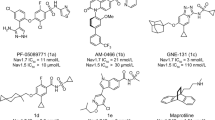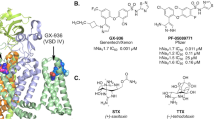Abstract
IN 1956 Stone, Torchiana, Navarro and Beyer1 discovered that powerful ganglion-blocking properties, hitherto demonstrated only in quaternary bases, were possessed by the secondary amine 3-methylaminoisocamphane (mecamylamine); nothing comparable has since been described. A study of a variety of secondary and tertiary bases in which the nitrogen atom is closely surrounded by alkyl groups has now shown that many polyalkylpiperidines (U.K. Patent Applications Nos. 4905/57, 4906/57 and 4907/57) are highly active as ganglion-blocking and hypotensive agents. The most promising of a large series examined were 1 : 2 : 2 : 6 : 6-pentamethylpiperidine (I; R = R
1 = R
2 = R
3 = R
4 = Me) and 1-ethyl-2 : 2 : 6 : 6-tetramethylpiperidine (I; R = Et; R
1 = R
2 = R
3 = R
4 = Me). These and related compounds were tested intravenously in the cat, anaesthetized with chloralose, for their ability to block preganglionic stimulation of the nictitating membrane. By this test, the pentamethyl compound was about 2.5 and the ethyl tetramethyl compound about 3.0 times as potent as mecamylamine and the effects of all three drugs were of similar duration, a single dose of 0.2 mgm./kgm. of the ethyl compound having a perceptible effect for approximately two hours. Both compounds also block the pressor response to phenyldimethylpiperazinium, carotid occlusion, and efferent splanchnic stimulation, and, in the atropinized cat, to acetyl choline, all these actions being impressive after doses of 0.1–0.2 mgm./kgm. of either drug. The drugs block the contraction of the guinea pig ileum, elicited in vitro by phenyldimethylpiperazinium, reduce intestinal motility in vivo as judged by rate of excretion of fæces by mice, and reduce the rate of spontaneous secretion of gastric juice in the rat. By the last test 1 : 2 : 2 : 6 : 6-pentamethylpiperidine is twice, and 1-ethyl-2 : 2 : 6 : 6-tetramethylpiperidine three times as potent as mecamylamine when all three drugs are given subcutaneously. 
This is a preview of subscription content, access via your institution
Access options
Subscribe to this journal
Receive 51 print issues and online access
$199.00 per year
only $3.90 per issue
Buy this article
- Purchase on Springer Link
- Instant access to full article PDF
Prices may be subject to local taxes which are calculated during checkout
Similar content being viewed by others
References
Stone, C. A., Torchiana, M. L., Navarro, A., and Beyer, K. H., J. Pharmacol., 117, 169 (1956).
Bennett, G., Tyler, C., and Zaimis, E., Lancet, ii, 218 (1957).
Author information
Authors and Affiliations
Rights and permissions
About this article
Cite this article
SPINKS, A., YOUNG, E. Polyalkylpiperidines: a New Series of Ganglion-blocking Agents. Nature 181, 1397–1398 (1958). https://doi.org/10.1038/1811397a0
Issue Date:
DOI: https://doi.org/10.1038/1811397a0
Comments
By submitting a comment you agree to abide by our Terms and Community Guidelines. If you find something abusive or that does not comply with our terms or guidelines please flag it as inappropriate.



